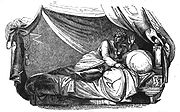
The Third Part of the Pilgrim's Progress
Encyclopedia

Sequel
A sequel is a narrative, documental, or other work of literature, film, theatre, or music that continues the story of or expands upon issues presented in some previous work...
to John Bunyan's
John Bunyan
John Bunyan was an English Christian writer and preacher, famous for writing The Pilgrim's Progress. Though he was a Reformed Baptist, in the Church of England he is remembered with a Lesser Festival on 30 August, and on the liturgical calendar of the Episcopal Church on 29 August.-Life:In 1628,...
The Pilgrim's Progress
The Pilgrim's Progress
The Pilgrim's Progress from This World to That Which Is to Come is a Christian allegory written by John Bunyan and published in February, 1678. It is regarded as one of the most significant works of religious English literature, has been translated into more than 200 languages, and has never been...
written by an anonymous
Anonymus
Anonymus is the Latin spelling of anonymous. This Latin spelling, however, is traditionally used by scholars in the humanities to refer to any ancient writer whose name is not known, or to a manuscript of their work...
author. It was published with Bunyan's work in editions from 1693 to 1852 because it was believed to be written by Bunyan. It presents the pilgrimage of Tender-Conscience and his companions. In the 19th century it was bowdlerized
Thomas Bowdler
Thomas Bowdler was an English physician who published an expurgated edition of William Shakespeare's work, edited by his sister Harriet, intended to be more appropriate for 19th century women and children than the original....
to omit a few sexual situations and allusions.
Plot
Tender-Conscience, a native of the town of Vain Delights goes on the pilgrimage of Christian and Christiana to the Celestial City. He stops at some of the same places as they, but he encounters new places not visited by either Christian or Christiana and her party.All of the lands that are outside of the Wicket Gate and the area encompassed by the "walls and borders of that region, wherein lay the way to the heavenly country" are known as the "Valley of Destruction." The time that Tender-Conscience begins his pilgrimage is a time of drought and heat, which is emblematic of a time of the persecution. Some of them are deterred in their progress, and return to their old homes in the Valley of Destruction during the night.
Tender-Conscience has a difficult time crossing the Slough of Despond, and he does not get by it without being covered in mud from it. This mud has the effect of weakening the body and blinding his eyes, and Tender-Conscience grope along until he is overshadowed by a bright cloud from which a hand appears that washes away the mud enabling Tender-Conscience to continue his journey with vigor.
At the Wicket Gate Tender-Conscience does not escape the arrows shot against callers from the Beelzebub's castle. These sick to his flesh and cause him to bleed profusely. Good-Will lets him in, and registers his name as a pilgrim. He gives Tender-Conscience a crutch that is made of wood from the Tree of Life (Lingnum Vitæ). This crutch stanches the bleeding and strengthens Tender-Conscience, who must bear with the arrows of Beelzebub until he reaches the House of the Interpreter.
The Interpreter removes the arrows of Beelzebub from Tender-Conscience's body and lodges him for the night, showing him the same emblems and scenes enjoyed by Christian, Christiana, and their children and companions. The next day the Interpreter goes a little way with Tender-Conscience to where the King's Highway is walled on either side by the Wall of Salvation. Before they reach this wall they come to two farms on either side of the way. The farm on the right is well-cared for and the one on the left is not. The Interpreter tells Tender-Conscience that this provides an example to pilgrim's that they should be like the caretaker of the farm on the right, who gradually improved his farm until it was in its present good condition.
Tender-Conscience when parted from the Interpreter comes to the place where Christian found the cross and the sepulchre. On either side of the cross were now erected two houses as competing lodging places for pilgrims. On the right was the House of Mourning, and on the left was the House of Mirth. The House of Mirth is like an ale house with carousing men, but the House of Mourning is tended by pious women called "matrons." Tender-Conscience decides to go to the House of Mourning despite the agitation induced in the men of the House of Mirth, who form a mob surrounding the House of Mourning demanding that Tender-Conscience be handed over to them. Three shining ones appear to Tender-Conscience promising to rescue him. The first shining one breathes on Tender-Conscience making him a new creature, the second clothes him in a white robe in place of his crimson clothes, and the third one gives him a sealed roll. With this change Tender-Conscience is able to get by unrecognized by the men from the House of Mirth and, so, go on his way.
At the Hill Difficulty Tender-Conscience had the choice of the three ways: the one going up the hill also called "Difficulty," the one going around the right hand of the hill called "Danger," and the one going around the left side of the hill called "Destruction." The broadness and pleasantness of the two byways induced Tender-Conscience to take the right-hand byway Danger. He thought that this way would also lead him to the top of the hill, but the growing denseness of the forest surrounding the way and the howlings of wild beasts that he heard induced him to go back to the foot of the hill. He then remembered the Bible passages that characterized the right way as narrow, so he chose to go up the hill by way of the steep and narrow path.

